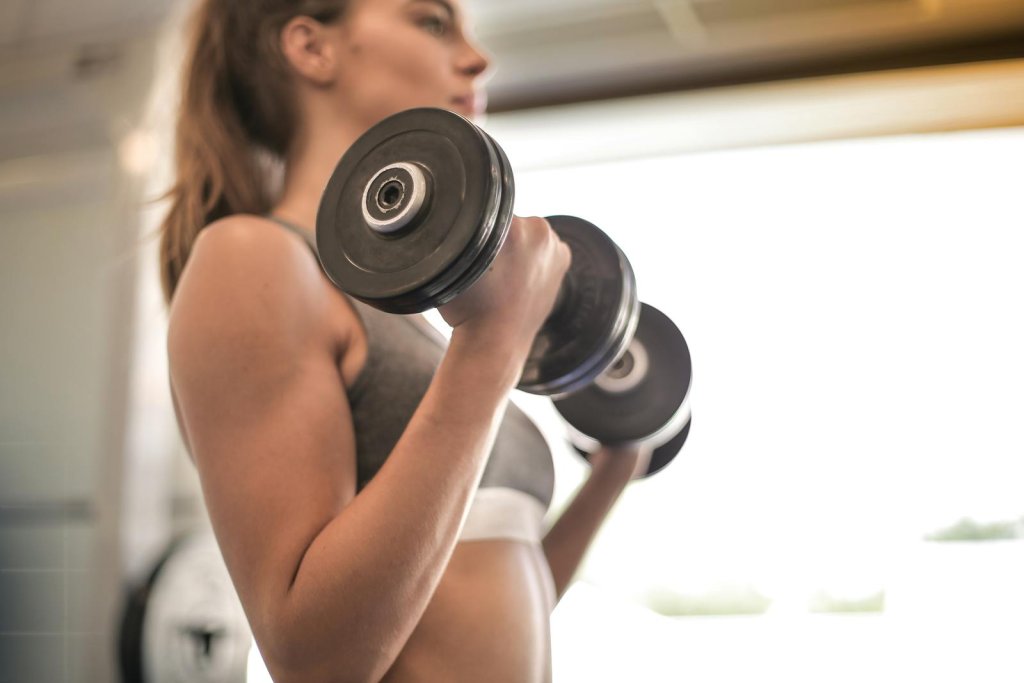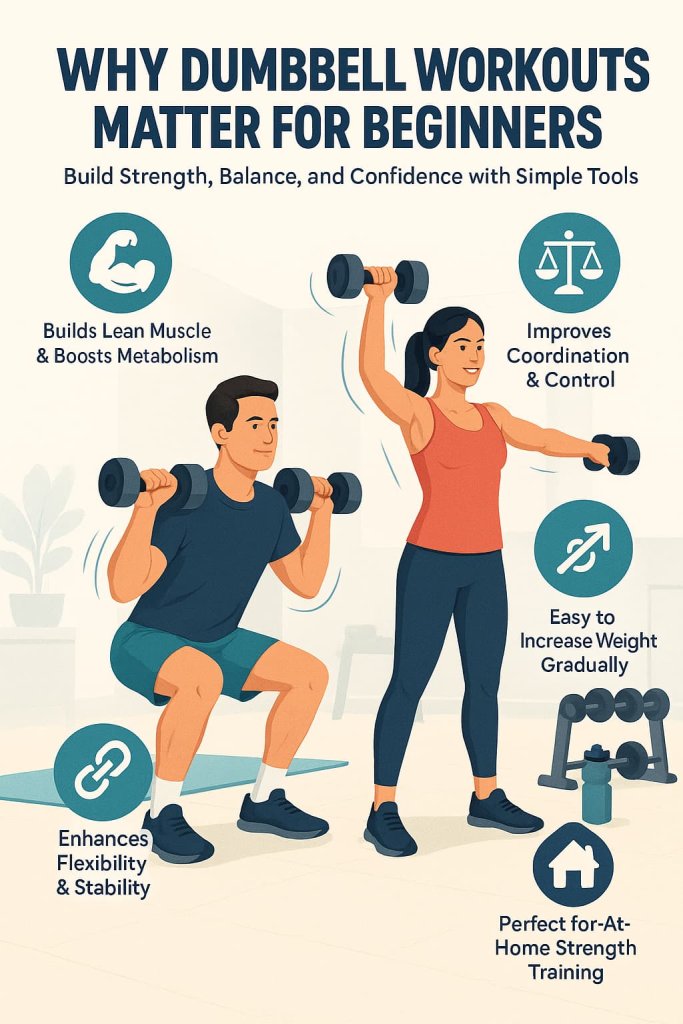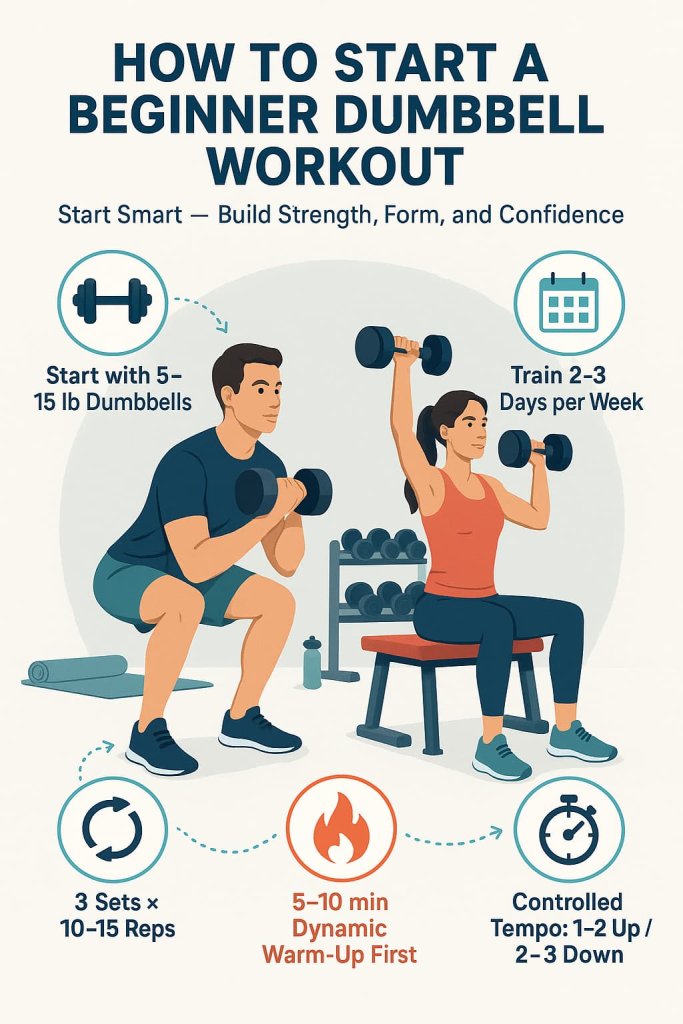If you’re new to fitness and wondering how to build strength fast with minimal equipment, dumbbells are your best starting point. These versatile weights help you gain muscle, boost metabolism, and improve balance — even at home.

According to Harvard Health, strength training with dumbbells twice per week supports bone health, posture, and long-term mobility. This beginner-friendly guide breaks down the 15 best dumbbell workouts to strengthen your entire body safely and effectively.
Why Dumbbell Workouts Matter for Beginners
Dumbbells are one of the most effective tools for building foundational strength. They engage stabilizer muscles, enhance coordination, and allow you to train through a full range of motion.
A 2023 meta-analysis found that free-weight training tends to improve strength more when measured with free-weight tests, while overall muscle growth is similar to machines.

Benefits include:
- Builds lean muscle and boosts metabolism
- Improves balance and coordination
- Increases joint stability and flexibility
- Allows progression with small weight increments
- Supports home workouts — no bulky machines required
How to Start a Beginner Dumbbell Workout

Before jumping in, here’s what you need:
- Weights: Start with 5–15 lb dumbbells depending on fitness level.
- Frequency: Train 2–3 days per week, resting 48 hours between sessions.
- Sets/Reps: 3 sets of 10–15 reps per exercise.
- Tempo: Control both lifting (1–2 seconds) and lowering (2–3 seconds).
Trainer Tip: Always warm up with 5 minutes of light cardio and dynamic stretches before lifting.
15 Best Dumbbell Workouts for Beginners
These 15 beginner dumbbell exercises build total-body strength, balance, and confidence — no machines required.
Start light, focus on form, and progress gradually to see noticeable results within weeks.
1. Dumbbell Squat
Why it works:
The dumbbell squat is one of the most effective compound exercises for beginners because it engages multiple large muscle groups at once. It strengthens your quads and glutes — the key drivers for walking, climbing stairs, and lifting. It also builds core stability and teaches proper movement mechanics for more advanced lower-body exercises later on.
Muscles worked: Quadriceps, gluteus maximus, hamstrings, erector spinae, and core.
How to do it:
- Stand tall with feet shoulder-width apart.
- Hold a dumbbell in each hand at your sides or at shoulder level for more challenge.
- Engage your core, push hips back, and bend knees to lower your body.
- Keep your chest upright and eyes forward.
- Lower until your thighs are parallel to the floor, then push through your heels to return to standing.
Trainer Tip:
Don’t let your knees cave inward — keep them in line with your toes. Exhale as you push up and inhale on the way down for proper breathing rhythm.
2. Dumbbell Deadlift
Why it works:
The dumbbell deadlift teaches hip hinge mechanics, which protect your back during daily activities like lifting groceries or bending down. It strengthens the posterior chain — the glutes, hamstrings, and lower back — improving posture, stability, and power output.
Muscles worked: Glutes, hamstrings, lower back, core, and grip muscles.
How to do it:
- Hold dumbbells in front of your thighs, palms facing inward.
- Stand with feet hip-width apart and shoulders pulled back.
- Push your hips backward as you lower the dumbbells toward your mid-shins.
- Keep your spine neutral and avoid rounding your back.
- Drive your hips forward to return to standing.
Trainer Tip:
Think of “pushing the hips back” instead of bending forward. This keeps the tension on your hamstrings, not your spine.
3. Dumbbell Bench Press
Why it works:
The bench press builds pressing strength across the chest, shoulders, and triceps. Dumbbells offer a greater range of motion than a barbell, improving muscle activation and shoulder stability — ideal for beginners.
Muscles worked: Pectorals, anterior deltoids, triceps, and core.
How to do it:
- Lie flat on a bench, dumbbells positioned at chest level.
- Press the weights upward until arms are fully extended without locking elbows.
- Lower the dumbbells slowly until your upper arms are parallel to the floor.
- Keep feet flat on the ground and your back neutral.
Trainer Tip:
Avoid flaring elbows out wide; a 45° angle protects shoulder joints and ensures better chest engagement.
4. Dumbbell Row
Why it works:
The dumbbell row improves upper-back strength, posture, and pulling mechanics. It balances out the pressing movements (like push-ups and bench presses) to prevent muscular imbalances.
Muscles worked: Latissimus dorsi, traps, rhomboids, posterior deltoids, and biceps.
How to do it:
- Place one knee and hand on a bench, keeping your back flat.
- Hold the dumbbell in the opposite hand with a neutral grip.
- Pull the dumbbell toward your ribs, leading with your elbow.
- Lower slowly under control.
Trainer Tip:
Avoid twisting your torso or using momentum. Focus on squeezing your back muscles at the top for one second before lowering.
5. Dumbbell Shoulder Press
Why it works:
This move strengthens your deltoids and triceps while teaching you to stabilize your spine. It’s one of the best exercises for developing overhead strength used in daily tasks like lifting boxes or carrying objects overhead.
Muscles worked: Deltoids (front, middle, rear), triceps, and core.
How to do it:
- Sit or stand with dumbbells at shoulder height, palms facing forward.
- Engage your core and press weights straight up.
- Pause briefly at the top, then lower to shoulder level.
Trainer Tip:
Keep your ribs tucked and avoid arching your back — it shifts the strain from your shoulders to your spine.
6. Dumbbell Lunge
Why it works:
This unilateral exercise builds lower-body strength, coordination, and balance. Lunges help correct muscle imbalances between legs and improve hip mobility.
Muscles worked: Glutes, quads, hamstrings, calves, and core.
How to do it:
- Hold dumbbells at your sides with a firm grip.
- Step one foot forward and lower your body until both knees form 90° angles.
- Keep your front knee aligned above your ankle.
- Push through your front heel to return to standing.
Trainer Tip:
Take shorter steps if you struggle with balance. Keep your torso upright — don’t lean forward.
7. Dumbbell Bicep Curl
Why it works:
Strengthens the biceps and improves grip endurance. It enhances performance in pulling exercises and contributes to aesthetic arm definition.
Muscles worked: Biceps brachii, brachialis, and forearms.
How to do it:
- Stand tall with dumbbells at your sides, palms facing forward.
- Curl both dumbbells up toward your shoulders.
- Squeeze your biceps at the top, then slowly lower to start.
Trainer Tip:
Keep your elbows pinned to your sides and move only your forearms. Avoid swinging or using body momentum.
8. Dumbbell Tricep Kickback
Why it works:
Targets the triceps for arm definition and helps strengthen the muscles used in pushing and pressing motions.
Muscles worked: Triceps brachii and posterior deltoids.
How to do it:
- Hinge forward at your hips, keeping your back straight.
- Hold dumbbells with elbows bent at 90°.
- Extend arms back until straight.
- Slowly return to start position.
Trainer Tip:
Focus on full extension — the squeeze at the end is where most of the muscle engagement happens.
9. Dumbbell Lateral Raise
Why it works:
Develops shoulder width and roundness for a balanced, athletic upper body. Also helps strengthen shoulder stabilizers that protect against injury.
Muscles worked: Lateral deltoids, supraspinatus, and upper traps.
How to do it:
- Stand with feet hip-width apart, dumbbells by your sides.
- Raise both arms out to the sides until at shoulder height.
- Pause briefly, then lower under control.
Trainer Tip:
Keep elbows slightly bent and thumbs slightly higher than pinkies to avoid shoulder impingement.
10. Dumbbell Step-Up
Why it works:
A functional lower-body move that builds leg power and balance while mimicking everyday activities like climbing stairs.
Muscles worked: Glutes, quads, hamstrings, calves, and core.
How to do it:
- Hold dumbbells at your sides.
- Step onto a bench or box with your right foot.
- Push through your heel to lift your body up.
- Step down slowly and repeat on the other leg.
Trainer Tip:
Choose a bench height that keeps your knee at a 90° angle or lower to protect joints.
11. Dumbbell Chest Fly
Why it works:
Isolates the pectoral muscles while enhancing flexibility and control through a wide range of motion.
Muscles worked: Pectorals, anterior deltoids, and biceps.
How to do it:
- Lie on a bench with dumbbells over your chest, palms facing each other.
- Lower arms out to the sides until you feel a chest stretch.
- Bring them back together in an arc motion, squeezing your chest at the top.
Trainer Tip:
Keep a slight bend in elbows and stop before weights go below shoulder level to avoid shoulder strain.
12. Dumbbell Goblet Squat
Why it works:
A beginner-friendly version of the squat that teaches proper depth, posture, and bracing without overloading the spine.
Muscles worked: Quads, glutes, hamstrings, and core.
How to do it:
- Hold a single dumbbell vertically at chest level.
- Stand with feet slightly wider than shoulder-width apart.
- Lower hips back and down into a deep squat.
- Drive through heels to return upright.
Trainer Tip:
Keep your elbows inside your knees at the bottom to maintain a tall chest.
13. Dumbbell Romanian Deadlift
Why it works:
Focuses on hip hinge mechanics and posterior chain strength, improving power and reducing lower back injury risk.
Muscles worked: Hamstrings, glutes, and spinal erectors.
How to do it:
- Hold dumbbells in front of thighs with soft knees.
- Push hips backward and lower weights until you feel a deep hamstring stretch.
- Keep chest lifted and spine neutral.
- Squeeze glutes to stand tall again.
Trainer Tip:
Move slowly — the eccentric (lowering) phase builds the most strength and flexibility.
14. Dumbbell Front Raise
Why it works:
Improves shoulder endurance and posture by targeting the front deltoids used in lifting or pushing objects.
Muscles worked: Anterior deltoids and upper chest.
How to do it:
- Stand tall holding dumbbells in front of thighs, palms facing down.
- Lift to shoulder height with controlled motion.
- Pause briefly, then lower slowly.
Trainer Tip:
Exhale as you lift; control the descent to avoid swinging the weights.
15. Dumbbell Plank Row
Why it works:
Combines strength and stability, working your entire core while also building back and arm power. It’s excellent for functional fitness and coordination.
Muscles worked: Core, lats, traps, biceps, and obliques.
How to do it:
- Begin in a high plank position, holding dumbbells directly under shoulders.
- Engage your core and row one dumbbell toward your ribcage.
- Lower it back down and repeat with the other arm.
Trainer Tip:
Widen your stance for stability. Keep your hips square and body rigid to maximize core engagement.
Safety Tips for Beginners
- Focus on form over weight to prevent injury.
- Increase resistance only when you can complete all reps with perfect form.
- Avoid jerky movements — lift and lower with control.
- Breathe: exhale on effort, inhale on lowering.
Sample Beginner Dumbbell Routine
| Day | Focus | Exercises |
|---|---|---|
| Day 1 | Upper Body | Bench Press, Row, Bicep Curl, Tricep Kickback |
| Day 2 | Lower Body | Goblet Squat, Deadlift, Lunge, Step-Up |
| Day 3 | Full Body | Shoulder Press, Lateral Raise, Plank Row, Chest Fly |
FAQ
1. How often should beginners use dumbbells?
2–3 times per week, with at least one rest day between sessions.
2. What dumbbell weight should I start with?
Start with 5–10 lbs for upper body and 10–20 lbs for lower body.
3. Can I build muscle with dumbbells only?
Yes. Progressive overload and consistency are key for muscle growth.
4. Should I do full-body or split routines?
Full-body routines are best for beginners to maximize efficiency and recovery.
5. How long until I see results?
Most beginners notice strength and tone improvements within 4–6 weeks.
6. Can I use adjustable dumbbells?
Absolutely — they’re space-saving and ideal for home workouts.
7. What’s the best warm-up before dumbbell training?
Try 5 minutes of light cardio and dynamic moves like arm circles, squats, and hip hinges.
Conclusion
Dumbbells are your simplest path to a stronger, more confident body. By mastering these 15 beginner moves, you’ll build strength, tone muscles, and create lasting fitness habits.
Start light, stay consistent, and increase the challenge gradually — that’s how beginners transform into confident lifters.
Ready to begin? Grab your dumbbells, follow the plan, and start building strength today.
